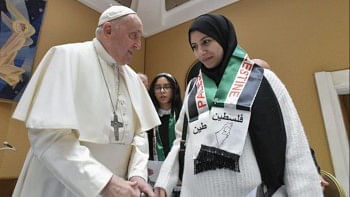China, India lead way in foreign aid
Bangladesh last year received record sums of aid commitments from China and India as the two regional giants look to one up each other in their push for geopolitical influence.
In fiscal 2017-18, various development partners made commitment of $14.86 billion, according to data from the Economic Relations Division.
Of the sum, China committed $4.35 billion and India $4.5 billion.
In fiscal 2016-17 the commitment made was $17.96 billion but $11.38 billion was by Russia for the Rooppur nuclear power plant project. If the amount is excluded, the commitment stands at $6.58 billion.
“We got a record amount of foreign aid commitment last fiscal year,” said an ERD official requesting anonymity.
As is practice, when a loan agreement is signed with a development partner it is considered actual commitment; the pledged fund is ready for utilisation.
For instance, during his visit to Bangladesh in 2016 Chinese President Xi Jinping promised $21.5 billion in soft loans to the country.
But, no loan agreement was signed then, so the sum was not entered in the log for foreign aid commitment made during the year. Of the sum offered by Xi, loan agreements worth $4.35 billion for five projects were signed with Chinese Exim Bank last fiscal year.
Some $2.66 billion was for a rail link project and Exim Bank released $533 million just a month after the signing of the loan agreement.
For the other four projects -- Karnaphuli tunnel ($705 million), a single point mooring with double pipelines ($550 million), modernisation of telecom sector ($280 million), and Infosarkar ($156 million) -- 20 percent of the amount has already been disbursed. During Prime Minister Sheikh Hasina's visit to New Delhi last year, India promised to provide $4.5 billion in loans and the ERD has already signed loan agreements with the neighbouring country's Exim Bank for the amount. Since 2010 India has committed to give $7.5 billion to Bangladesh under three lines of credit.
But the utilisation of the loans is low: in the last eight and a half years only $607 million could be utilised.
The reason for the unhurried utilisation of the loans is complexities in the projects rather than the neighbouring country dragging its feet in parting with the amount, said the ERD official.
Apart from this, last year another big development partner Japan committed $1.83 billion in loan.
And the traditional development partners, the World Bank and the Asian Development Bank, made big sums of aid commitment.
World Bank President Jim Yong Kim after a meeting with Finance Minister AMA Muhith on Sunday told reporters that the Washington-based multilateral lender has lent a record amount to Bangladesh this year: $3 billion.
Globally, this is the second largest amount lent out by the WB, he said.
Meanwhile, utilisation of foreign aid kept pace with commitment last fiscal year. In the first 11 months of fiscal 2017-18, aid utilisation was $4.69 billion, according to ERD statistics.
June's figure has not been accounted for thoroughly; as per provisional statistics, aid utilisation last fiscal year stood at $6.1 billion.
“This is a new record,” the ERD official said. The highest foreign aid utilisation was recorded in fiscal 2016-17: $3.68 billion.
The majority of the disbursement made last fiscal year was loans from the WB, the ADB, Japan International Cooperation Agency and China.
Last fiscal year, China disbursed $1 billion.
As the aid commitment is increasing every year, so is the unutilised foreign aid in the pipeline.
On June 30 this year the amount of foreign aid in the pipeline will most definitely cross the $40 billion mark, up from $35.75 billion a year earlier, according to ERD officials.

 For all latest news, follow The Daily Star's Google News channel.
For all latest news, follow The Daily Star's Google News channel. 



Comments